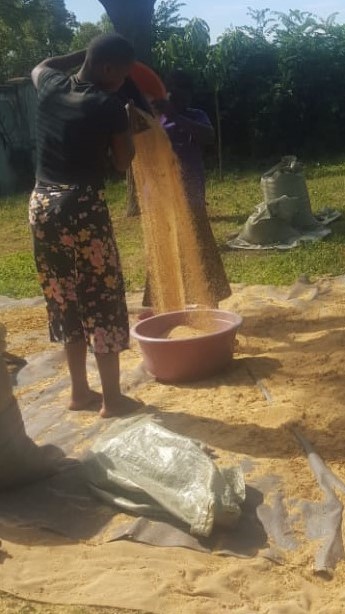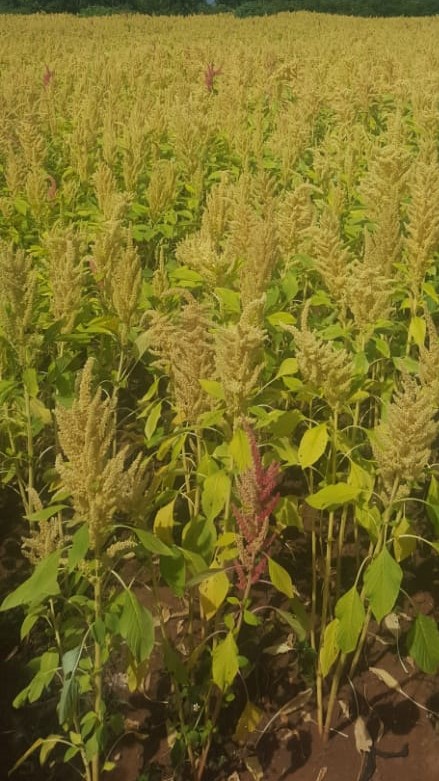 Workers winnowing amaranth grains. Photo courtesy.
Workers winnowing amaranth grains. Photo courtesy.
An amaranth farmer from Western Kenya is banking on the increasing demand for the crop’s grains to up her production and income.
Carolyne Okello, the farmer from Ringa Kakelo in Homa Bay County, says amaranth grains fetched Sh150 a kilo three years ago when she started the venture on an acre piece of plot but now the price has increased to between Sh200-300 prompting her to increase the acreage under production to six.
“In 2016 when I started amaranth farming, I could sell the grains at Sh150 or even less in local markets as many were still unaware of the nutritional and medicinal value of it but now the crops has grown in demand and consumers now use it in their daily meals,” she said.
Amaranth, the “pseudo-cereal” (a non-grass cereal) can be roasted and eaten as such or grounded to produce flour to fortify maize meal flour, make porridge, chapati, cookies, cakes, pancakes, bread muffins, crackers, pasta and other bakery products.
RELATED ARTICLE: Nutritionist proves that Amaranth weed has bundles of money hidden in its grain
Nutritionists assert that the grains are best for cancer and diabetic patients as it is a good source of fiber, protein, manganese, magnesium, phosphorus and iron, along with several other important micronutrients. It can be used to make animal feeds and skin cosmetics.
The green fresh leaves can be cooked and eaten as vegetable and Carolyne says that she used to sell them at Sh40-80 per kilo in local markets but now she gives them out to neighbours and friends for free for consumption to focus on grains. The leaves are a good source of protein, pro-vitamin A, vitamin C, and fiber.
According to a 2018 research on Efforts to Promote Amaranth Production and Consumption in Uganda to Fight Malnutrition, amaranth grains have protein content of 12-13 per cent, which is higher than that of most cereal grains making it the most sort after grain globally.
RELATED ARTICLE: Amaranth: from weed to wonder crop

Amaranth crop. Photo courtesy.
Grain Amaranth has two main varieties, the short and tall varieties recommended for low and high rainfall areas. Maturity occurs in 45 – 60 days for early maturing (short) varieties while late maturing (tall) varieties take 70- 120 days.
The two drought tolerant varieties can yield an average of 800 – 1200 kilogram per acre and can fetch over Sh200 per kilo by local companies which process and sell grain amaranth products.
RELATED ARTICLE: Food fortification offers amaranth seeds market
Currently, Carolyne has already harvested ten- 90kg sacks of amaranth grains expecting to hit 30-35 such sacks at the end of the season.
“I expect good harvest in the next two weeks. The already harvested grains are now being dried to attain a required moisture content of 13 per cent then winnowed and packed for market,” she said.
She expects 2,700 kilograms which she sells at Sh200 which is the lowest price will earn her over Sh0.5m.
Her main challenge with local traders is late payment as they (traders) need to sell the grains before paying and then they pay after 2-3 weeks hence she welcomes any other market which can pay cash on delivery of upon collection.
“Local business people take long to pay back even after supplying them with the produce that is why I would appreciate any other reliable market in terms of buying and payments,” said Carolyne.
Due to the increase in demand, other companies have also taken up the growing of the crop. According to National Farmers Information Service (NAFIS), today there are over six companies in the country that offer farmers both local and international markets.
The companies include Amaranth International Ltd, Incas Health International Ltd, African Amarantha ltd, Amaranth Grain Ltd, MAP international and All Grain Company Kenya Ltd spread across the country.
Carolyne can be reached on +254 727 862671